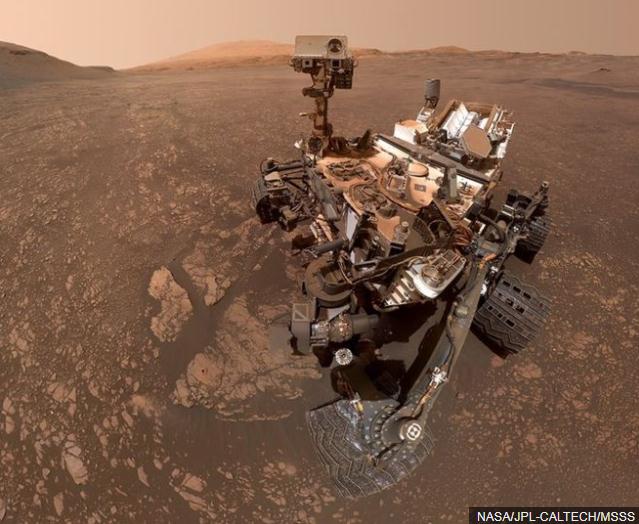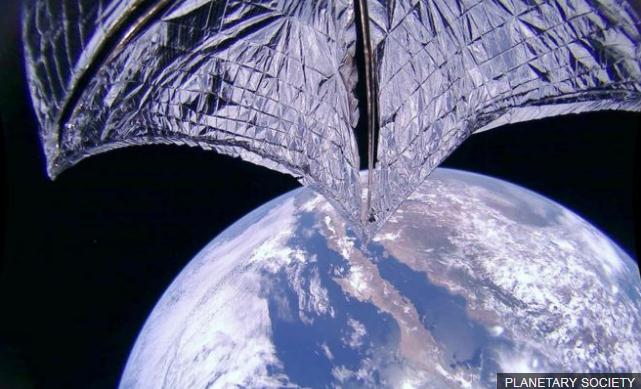随着一些重磅太空任务展开,2019年见证了一些从太阳系各处传回地球的绝妙影像。与此同时,一些最强大的望远镜拍摄了宇宙中最迷人的目标,月球背面、恒星烟花……一起欣赏英国广播公司近日盘点的2019年最佳太空照片。
Up in the clouds
木星云带

Nasa's Juno spacecraft has been sending back stunning images of Jupiter's clouds since it arrived in orbit around the giant planet in 2016. This amazing, colour-enhanced view shows patterns that look like they were created by paper marbling. The picture was compiled from four separate images taken by the spacecraft on 29 May.
自2016年美国国家航空航天局的“朱诺”号探测器抵达木星轨道后,就一直在发回木星云带令人震惊的图像。一张令人惊叹的调色照片显示了看起来像是由大理石花纹纸创造出来的图案。这张照片是由“朱诺”号探测器在2019年5月29日拍摄的四张单独照片合成的。

The snowman
雪人

After its swing-by exploration of Pluto in 2015, Nasa's New Horizons spacecraft was sent after a different target in the distant Kuiper Belt, which lies beyond the orbit of Neptune. This belt is populated by thousands of primitive, icy objects that provide insights into the very beginnings of our Solar System.
在2015年对冥王星进行探测后,美国国家航空航天局的“新视野”号探测器前往遥远的柯伊伯带寻找另一个目标,那里位于海王星轨道之外。柯伊伯带有数千个原始的冰状物体,人类可以从中洞察太阳系的起源。
swing-by:短暂拜访
Kuiper Belt:柯伊伯带(数十亿颗在海王星轨道之外绕行的小型冰体构成的碟形带)
Scientists settled on an object called MU 69, which had only been discovered in 2014. MU 69 (later called Ultima Thule, and now Arrokoth) turned out to be a 39km-long "contact binary", composed of two different icy balls that collided at low speed. The reddish colouration is caused by organic compounds called tholins on the surface.
科学家们将目标锁定为一个名为MU69的物体,它是在2014年才被发现的。MU69(后来被叫做“天涯海角”,现在取名“天空”)其实是一个长39公里的“相接双星”,由两个低速碰撞的冰球组成。其红色外表是由被称为托林的有机化合物造成的。
Stellar fireworks
恒星烟花

Eta Carinae is a star system located around 7,500 light-years away. It consists of at least two stars that, combined, emit about five million times more energy than our Sun. One of the stars has been releasing hot gas that has expanded into a pair of ballooning lobes. For decades, astronomers have wondered whether it is on the brink of destruction, and will erupt in a violent supernova. This latest image of the stellar fireworks display was released this year, and was taken by the Wide Field Camera 3 on the Hubble Space Telescope.
海山二是位于大约7500光年外的一个恒星系统。它由至少两颗恒星组成,它们释放的总能量约为太阳的500万倍。其中一颗恒星释放出热气,扩大成一对膨胀的气囊。几十年来,天文学家一直怀疑它是否处于毁灭的边缘,并将发生超新星爆炸。这张最新的恒星烟花图像是2019年发布的,由哈勃太空望远镜上的第三代宽视场照相机拍摄。
Martian selfie
火星自拍

Nasa's Curiosity rover has been exploring Gale Crater on Mars since 2012. The robot took this "selfie" as it explored the slopes of Mount Sharp - a mountain that forms the central peak of the impact depression.
美国国家航空航天局的“好奇”号火星车自2012年以来一直在探测火星上的盖尔陨石坑。这个机器人在探索夏普山斜坡时拍下了一张自拍照——夏普山形成了冲击洼地的中心顶峰。
Two samples of rock drilled from this site showed exceptionally high amounts of clay minerals. Clay often forms in the presence of water, which is a key ingredient for life. Previous evidence had shown that water once pooled in Gale Crater.
这里钻出的两份岩石样品显示了极大量的粘土矿物。粘土通常有水才能形成,水对生命至关重要。此前的证据表明,盖尔陨石坑曾经有水聚集。
Far side of the Moon
月球背面

On 3 January this year, China's Chang'e-4 spacecraft became the first mission to perform a soft landing on the far side of the Moon. A few days after the touchdown, cameras on the robotic rover and its lander were commanded to take photos of one another.
2019年1月3日,中国的嫦娥四号探测器成为首个在月球背面软着陆的探测器。着陆几天后,着陆器及巡视器奉命相互拍照。

A galactic rival
银河的对手

This image taken by the Hubble telescope shows a spiral galaxy called NGC 772, which lies 130 million light-years away. NGC 772 has much in common with our own Milky Way galaxy. For instance, both the Milky Way and NGC 772 have small satellite galaxies, which closely orbit their parent galaxies.
这幅哈勃望远镜拍摄的照片展示了一个名为NGC772的螺旋星系,它位于1.3亿光年以外。NGC772与我们的银河系有很多共同之处。例如,银河系和NGC772都有小型的卫星星系,紧密围绕母星系运行。
However, the two are also different in a few key ways. For example, NGC 772 lacks a central feature called a bar, which is built of gas and stars and is thought to help funnel material through the core of a galaxy - perhaps fuelling star formation.
不过,两者在几个关键方面也存在不同。例如,NGC772缺少名为棒状结构的中心特征,这种结构由气体和恒星构成,据信可以帮助物质通过星系核心——或许能为恒星的形成提供燃料。
We are sailing
我们扬帆飞行

LightSail is a project developed by the non-profit organisation The Planetary Society. Its purpose is to demonstrate solar sailing in low-Earth orbit. Solar sails are a long-discussed way of propelling spacecraft. The sails exploit the fact that sunlight exerts pressure on a mirrored surface. This can, in theory, be used for propulsion in a way that's akin to a sail being blown by the wind.
“光帆”是由美国非营利组织行星学会开发的项目。其目的是展示近地轨道上的太阳帆技术。太阳帆是科学家一直在探讨的推动飞行器的方式。这些帆利用了阳光会对镜面施加压力这一事实。从理论上讲,这种压力可以用于推进,类似风吹动帆。
LightSail 2 was launched on 25 June 2019. This image shows the sail after its deployment on 23 July.
“光帆2号”于2019年6月25日发射升空。这张照片展示了7月23日太阳帆张开时的情景。
请关注 : 佛山市傲尔登家具 酒店家具床垫 新款弹簧床垫